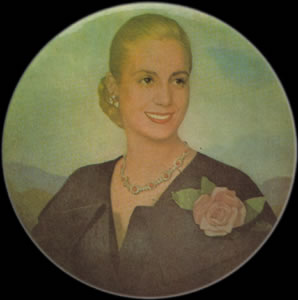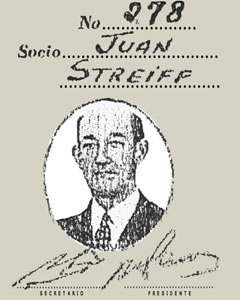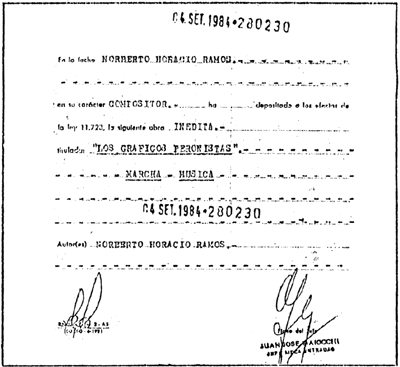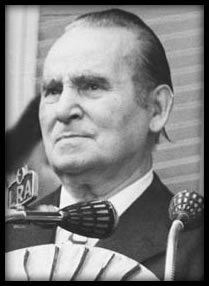By
The origin of the Peronist march rooted in sports and carnival chants

or 50 years Peronism left an indelible mark on the Argentine political life. With a “movement-style” pattern, it vindicated the poorest sectors and placed the workers onto the political scene, so they organized themselves in an only one workers’ union, the C.G.T.
It was and it still is the paradigm of something popular and has, as an emerging attribute, the nicest and catchiest political party march. Envied by the rest of the political field —because of its fervent melody with a contagious enthusiasm— it’s tenderly called the little march (la marchita).

“Los muchachos peronistas” was officially premiered when the singer Hugo del Carril committed it to record. The intention was to air it on the anniversary of the Loyalty Day (Día de la Lealtad), October 17, 1949.
What is strange is that, after so many years of that event, people still discuss about its origins and who the creators of its music and lyrics were.
As for the composition, with the passing of time, every time the issue was alluded the names of the musician and lyricist Rodolfo Sciammarella —author of tangos and many commercial jingles—, of the Lomuto brothers, Blas and Francisco and, lastly, the name of the pianist Norberto Ramos arose. We shall talk about them below.
On October 17, 1992, in the La Nación daily issue, the journalist Hugo Gambini states that, much earlier, a club in a neighborhood had the chords of the “Los muchachos peronistas” as its march. The article does not explain it but it refers to the first section of the melody.
Also Eduardo Giorlandini, in his notes for the Tango y Lunfardo magazine directed by the well-remembered friend Gaspar Astarita, added an unknown name: Vicente Cóppola, who around 1926, with a carnival march won the first prize at a talent contest for “murgas” (costumed groups). He says, with no further explanation, that the melody for the later creation of “Los muchachos peronistas” comes from there. Here there was no explanation either, but it refers to the refrain or chorus of the march.
We are coming nearer the truth. The carnival and the murgas are still present but we have now to focus the thing in the neighborhood of Barracas. More precisely on 1400 Río Cuarto Street where the headquarters of the Barracas Juniors club was located. In front of it Juan Raimundo Streiff lived. He was an electromechanical technician, a post office clerk, and also a bandoneon player and he even led a simple tango orchestra: Streiff-Garaventa which made several appearances on the radio.
 An amusing man, loved by his neighbors, who on holidays and, especially, on carnival days, was a kind of attraction because he used to stroll along the streets playing melodies of his own with his instrument hanging from his neck. One of them attracted the attention of the boys of the club who decided to create a march that represented them and praised their humble achievements. As for the lyrics they turned to a neighbor, a specialist in murgas, “El turco Mufarri” (the Turk). So in the late twenties the march of the Barracas Juniors club was born.
An amusing man, loved by his neighbors, who on holidays and, especially, on carnival days, was a kind of attraction because he used to stroll along the streets playing melodies of his own with his instrument hanging from his neck. One of them attracted the attention of the boys of the club who decided to create a march that represented them and praised their humble achievements. As for the lyrics they turned to a neighbor, a specialist in murgas, “El turco Mufarri” (the Turk). So in the late twenties the march of the Barracas Juniors club was born.
Los muchachos de Barracas
todos juntos cantaremos
y al mismo tiempo daremos
un hurra de corazón.
Por esos bravos muchachos
que lucharon con fervor
por defender los colores
de esta gran institución.
Juan Carlos Streiff, son of the above mentioned musician, said the piece was never filed in the record but on one occasion a group of people recorded it on a disc which later disappeared.
At this time of the story we can say that the Gambini’s and the Giorlandini’s statements are not contradictory but they complement each other.
Soon thereafter the fans of the club began to repeat, like a refrain, the music and the lyrics of a costumed carnival gang of La Boca, adding to the club anthem made by Streiff and Mufarri the exact bars of what later would be the chorus of the Peronist march.
¿Pa' qué bebés
si no sabés?
¿Pa' qué tomás
si te hace mal?
¡Tomá tomate
te hace bien!
This was confirmed by our friend Emilio Zamboni, who knowing about our research, surprised us by singing exactly what was transcribed above.
He told us that he learnt the tune when he was a kid because, as a joke, his father who played guitar used to sing it in the thirties.
Another version is given by Héctor Benedetti in his book "Las mejores anécdotas del tango y otras curiosidades". He says that the march was composed by the pianist Norberto Ramos who was member of the Los Ases quartet, of the Florindo Sassone's orchestra and of the Trío Yumba. He filed "Los gráficos peronistas" whose music is the same as the one of the political party march.
The source is, surely, an interview to Ramos, made by Juan Ayala for the La Maga magazine in 1995: «In 1948 my father worked as a graphic industry worker at the Atlántida publishing company. I was 15 then and he turned up with some fellow workers: Rafael Lauría, Enrique Odera and Guillermo de Prisco. They wanted to make a march for the Peronist workers of the graphic industry and needed me to write down the music. They sang for me the "Perón, Perón, que grande sos" with a melody which they told me was used by a carnival group. Ten days later I had written the first section. Lauría had the responsibility of the lyrics. He went to the Grafasón studios and recorded "Los gráficos peronistas" there. The lyric was as follows:
Los gráficos peronistas
todos juntos triunfaremos
y al mismo tiempo daremos
un hurra de corazón
¡Viva Perón! ¡Viva Perón!
Por ese gran argentino
que se supo conquistar
a la gran masa del pueblo
combatiendo el capital.
¡Perón, Perón, que grande sos!
¡Mi general cuanto valés!
¡Perón, Perón, gran conductor!
Sos el primer trabajador.
He later said that: «... anyone who knows a little music realizes that the melody was devised by a kid, since it is based on three notes of a minor tonality and its dominant. Because of that it succeeded, because it was simple. I never thought of filing it in the registry because when I was fifteen the only thing I liked was to play with Los Ases. When the "revolución libertadora" came, I was incapable of doing anything, I couldn't say that the march belonged to me. Furthermore, I had no document to prove it».
He insisted: «I ought to collect each time that "Los muchachos peronistas" is aired because the music is mine, but as Law 11.723 establishes that a piece is not divisible, I collect nothing because I didn't write the lyric and there's no one that acknowledges that Lauría made it, not even his son».
On November 1, 1983 Ramos went to SADAIC to file his piece but he found it was already filed in the record as written by an anonymous author. The following year he managed to file "Los gráficos peronistas".

We don't take into consideration this version by the pianist, because the first section he says he has composed already existed in the march of the Barracas Juniors club and the lines that include the term "hurrah" betray its origin rooted in sports. Ramos never said the chorus was his.
Juan Carlos Streiff added some vicissitudes that his father and his family underwent: «It could have never been composed in 1948 because I very well recall that it had been recorded and I heard the record much before it was stolen. When it began to be sung by people in the streets my father, on one side, liked it but, on the other side, he didn't because he was not Peronist. When Perón was ousted, almost immediately, some Navy officers came to my place to ask how much Perón had paid my father for composing it. They found a man old and sick, living with his family in a very poor condition».
The name of Rodolfo Sciammarella appears, possibly, due to a mistake because he was the author of several numbers connected with Peronism. Some of them were sung by his wife Estrella and he is as well author of a march requested from Brazil for a campaign for the presidential elections.
The mentioning of the Lomuto brothers, contributors with the Peronist movement, is another confusion because they were the authors of the "4 de junio" march.
The story of the lyric is a puzzle, but easy to put together.
When talking about the music we have already commented about that lyric by "El Turco Mufarri" for the march for the Club Barracas Junior in the late twenties. Nearly two decades later is the time for Rafael Lauría —whom we mentioned above— who was the secretary in the graphic industry union. This entity issued a magazine for its affiliates and, in one of its numbers, Lauría published some verses titled "Los gráficos peronistas". An affiliate said that he knew the march of a club in Barracas in whose melody these verses may very well fit.
The physician Oscar Ivanissevich in his book of memoirs "Rindo cuenta" says: «on one of our visits to the "Democracia" paper with Mrs. Perón we were climbing the stairs while we, with my friend Guillermo de Prisco, were softly singing a tune that he had told me was the march of "Los gráficos peronistas". Later, when we were going out, we continued it on the sidewalk and the lady told us: "The song is quite pretty, let's go to the president's house so that the General hears it".»
 «In September 1948 —says De Prisco in Ayala's note— I traveled with Ivanissevich to Tucumán where there was a social uneasiness because of a sabotage that had failed. He physician remembered the march and started to write new lines and to improve some of the existing ones. We ordered to print 30.000 copies. The title was already "Los muchachos peronistas". They were handed out to the people assembled in front of the provincial government house and, helped by a folk quartet of the Fábrica Argentina de Alpargatas, we began to sing. People got used to it immediately and we realized the enormous power which arose from that march. Our partner José Spath had brought a rudimentary recorder and our recording allowed us to widespread the march through a loudspeaker on a truck along the streets. On his comeback to Buenos Aires the physician asked the choir conductor, María Teresa Volpe de Pierángeli, to make a few corrections to it and after several rehearsals we, a group of people, recorded it at the top of our voices in the Victor studios as a private recording under the name of the Peronist party». (disc N° P.911)
«In September 1948 —says De Prisco in Ayala's note— I traveled with Ivanissevich to Tucumán where there was a social uneasiness because of a sabotage that had failed. He physician remembered the march and started to write new lines and to improve some of the existing ones. We ordered to print 30.000 copies. The title was already "Los muchachos peronistas". They were handed out to the people assembled in front of the provincial government house and, helped by a folk quartet of the Fábrica Argentina de Alpargatas, we began to sing. People got used to it immediately and we realized the enormous power which arose from that march. Our partner José Spath had brought a rudimentary recorder and our recording allowed us to widespread the march through a loudspeaker on a truck along the streets. On his comeback to Buenos Aires the physician asked the choir conductor, María Teresa Volpe de Pierángeli, to make a few corrections to it and after several rehearsals we, a group of people, recorded it at the top of our voices in the Victor studios as a private recording under the name of the Peronist party». (disc N° P.911)
Because of all what was said above, we come to the conclusion that the music, in its first section, belongs to Juan Raimundo Streiff and that the refrain is an anonymous popular air used by carnival costumed groups. Maybe the contribution by Norberto Ramos may have been transcribing the melody into a music staff, besides an arrangement for its recording.
As for the lyrics, its authors were Rafael Lauría and Oscar Ivanissevich, copying mostly the early lines by El Turco Mufarri —for the Club Barracas Juniors march— and adding others.